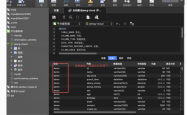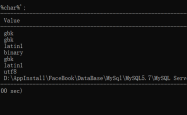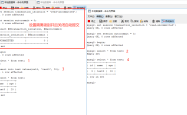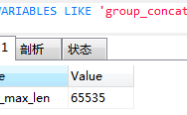MySQL和Python交互的示例
目录
一.准备数据
创建数据表
| 1 2 3 4 5 6 7 8 9 10 11 12 13 14 15 16 | -- 创建 "京东" 数据库 create database jing_dong charset=utf8; -- 使用 "京东" 数据库 use jing_dong; -- 创建一个商品goods数据表 create table goods( id int unsigned primary key auto_increment not null , name varchar (150) not null , cate_name varchar (40) not null , brand_name varchar (40) not null , price decimal (10,3) not null default 0, is_show bit not null default 1, is_saleoff bit not null default 0 ); |
插入数据
| 1 2 3 4 5 6 7 8 9 10 11 12 13 14 15 16 17 18 19 20 21 22 23 | -- 向goods表中插入数据 insert into goods values (0, 'r510vc 15.6英寸笔记本' , '笔记本' , '华硕' , '3399' , default , default ); insert into goods values (0, 'y400n 14.0英寸笔记本电脑' , '笔记本' , '联想' , '4999' , default , default ); insert into goods values (0, 'g150th 15.6英寸游戏本' , '游戏本' , '雷神' , '8499' , default , default ); insert into goods values (0, 'x550cc 15.6英寸笔记本' , '笔记本' , '华硕' , '2799' , default , default ); insert into goods values (0, 'x240 超极本' , '超级本' , '联想' , '4880' , default , default ); insert into goods values (0, 'u330p 13.3英寸超极本' , '超级本' , '联想' , '4299' , default , default ); insert into goods values (0, 'svp13226scb 触控超极本' , '超级本' , '索尼' , '7999' , default , default ); insert into goods values (0, 'ipad mini 7.9英寸平板电脑' , '平板电脑' , '苹果' , '1998' , default , default ); insert into goods values (0, 'ipad air 9.7英寸平板电脑' , '平板电脑' , '苹果' , '3388' , default , default ); insert into goods values (0, 'ipad mini 配备 retina 显示屏' , '平板电脑' , '苹果' , '2788' , default , default ); insert into goods values (0, 'ideacentre c340 20英寸一体电脑 ' , '台式机' , '联想' , '3499' , default , default ); insert into goods values (0, 'vostro 3800-r1206 台式电脑' , '台式机' , '戴尔' , '2899' , default , default ); insert into goods values (0, 'imac me086ch/a 21.5英寸一体电脑' , '台式机' , '苹果' , '9188' , default , default ); insert into goods values (0, 'at7-7414lp 台式电脑 linux )' , '台式机' , '宏碁' , '3699' , default , default ); insert into goods values (0, 'z220sff f4f06pa工作站' , '服务器/工作站' , '惠普' , '4288' , default , default ); insert into goods values (0, 'poweredge ii服务器' , '服务器/工作站' , '戴尔' , '5388' , default , default ); insert into goods values (0, 'mac pro专业级台式电脑' , '服务器/工作站' , '苹果' , '28888' , default , default ); insert into goods values (0, 'hmz-t3w 头戴显示设备' , '笔记本配件' , '索尼' , '6999' , default , default ); insert into goods values (0, '商务双肩背包' , '笔记本配件' , '索尼' , '99' , default , default ); insert into goods values (0, 'x3250 m4机架式服务器' , '服务器/工作站' , 'ibm' , '6888' , default , default ); insert into goods values (0, '商务双肩背包' , '笔记本配件' , '索尼' , '99' , default , default ); |
二.SQL演练
1. SQL语句的强化
查询类型cate_name为 '超极本' 的商品名称、价格
| 1 | select name ,price from goods where cate_name = '超级本' ; |
显示商品的种类
| 1 | select cate_name from goods group by cate_name; |
求所有电脑产品的平均价格,并且保留两位小数
| 1 | select round( avg (price),2) as avg_price from goods; |
显示每种商品的平均价格
| 1 | select cate_name, avg (price) from goods group by cate_name; |
查询每种类型的商品中 最贵、最便宜、平均价、数量
| 1 | select cate_name, max (price), min (price), avg (price), count (*) from goods group by cate_name; |
查询所有价格大于平均价格的商品,并且按价格降序排序
| 1 2 3 | select id, name ,price from goods where price > ( select round( avg (price),2) as avg_price from goods) order by price desc ; |
查询每种类型中最贵的电脑信息
| 1 2 3 4 5 6 7 8 9 10 11 | select * from goods inner join ( select cate_name, max (price) as max_price, min (price) as min_price, avg (price) as avg_price, count (*) from goods group by cate_name ) as goods_new_info on goods.cate_name=goods_new_info.cate_name and goods.price=goods_new_info.max_price; |
2. 创建 "商品分类"" 表
| 1 2 3 4 5 | -- 创建商品分类表 create table if not exists goods_cates( id int unsigned primary key auto_increment, name varchar (40) not null ); |
查询goods表中商品的种类
| 1 | select cate_name from goods group by cate_name; |
将分组结果写入到goods_cates数据表
| 1 | insert into goods_cates ( name ) select cate_name from goods group by cate_name; |
3. 同步表数据
通过goods_cates数据表来更新goods表
| 1 | update goods as g inner join goods_cates as c on g.cate_name=c. name set g.cate_name=c.id; |
4. 创建 "商品品牌表" 表
通过create...select来创建数据表并且同时写入记录,一步到位
| 1 2 3 4 5 6 7 | -- select brand_name from goods group by brand_name; -- 在创建数据表的时候一起插入数据 -- 注意: 需要对brand_name 用as起别名,否则name字段就没有值 create table goods_brands ( id int unsigned primary key auto_increment, name varchar (40) not null ) select brand_name as name from goods group by brand_name; |
5. 同步数据
通过goods_brands数据表来更新goods数据表
| 1 | update goods as g inner join goods_brands as b on g.brand_name=b. name set g.brand_name=b.id; |
6. 修改表结构
查看 goods 的数据表结构,会发现 cate_name 和 brand_name对应的类型为 varchar 但是存储的都是数字
| 1 | desc goods; |
通过alter table语句修改表结构
| 1 2 3 | alter table goods change cate_name cate_id int unsigned not null , change brand_name brand_id int unsigned not null ; |
7. 外键
分别在 goods_cates 和 goods_brands表中插入记录
| 1 2 | insert into goods_cates( name ) values ( '路由器' ),( '交换机' ),( '网卡' ); insert into goods_brands( name ) values ( '海尔' ),( '清华同方' ),( '神舟' ); |
在 goods 数据表中写入任意记录
| 1 2 | insert into goods ( name ,cate_id,brand_id,price) values ( 'LaserJet Pro P1606dn 黑白激光打印机' , 12, 4, '1849' ); |
查询所有商品的详细信息 (通过内连接)
| 1 2 3 | select g.id,g. name ,c. name ,b. name ,g.price from goods as g inner join goods_cates as c on g.cate_id=c.id inner join goods_brands as b on g.brand_id=b.id; |
查询所有商品的详细信息 (通过左连接)
| 1 2 3 | select g.id,g. name ,c. name ,b. name ,g.price from goods as g left join goods_cates as c on g.cate_id=c.id left join goods_brands as b on g.brand_id=b.id; |
- 如何防止无效信息的插入,就是可以在插入前判断类型或者品牌名称是否存在呢 可以使用之前讲过的外键来解决
- 外键约束:对数据的有效性进行验证
- 关键字: foreign key,只有 innodb数据库引擎 支持外键约束
- 对于已经存在的数据表 如何更新外键约束
| 1 2 3 4 5 6 | -- 给brand_id 添加外键约束成功 alter table goods add foreign key (brand_id) references goods_brands(id); -- 给cate_id 添加外键失败 -- 会出现1452错误 -- 错误原因:已经添加了一个不存在的cate_id值12,因此需要先删除 alter table goods add foreign key (cate_id) references goods_cates(id); |
- 如何在创建数据表的时候就设置外键约束呢
- 注意: goods 中的 cate_id 的类型一定要和 goods_cates 表中的 id 类型一致
| 1 2 3 4 5 6 7 8 9 10 11 | create table goods( id int primary key auto_increment not null , name varchar (40) default '' , price decimal (5,2), cate_id int unsigned, brand_id int unsigned, is_show bit default 1, is_saleoff bit default 0, foreign key (cate_id) references goods_cates(id), foreign key (brand_id) references goods_brands(id) ); |
如何取消外键约束
| 1 2 3 4 | -- 需要先获取外键约束名称,该名称系统会自动生成,可以通过查看表创建语句来获取名称 show create table goods; -- 获取名称之后就可以根据名称来删除外键约束 alter table goods drop foreign key 外键名称; |
在实际开发中,很少会使用到外键约束,会极大的降低表更新的效率
三.数据库的设计

创建 "商品分类" 表(之前已经创建,无需再次创建)
| 1 2 3 4 | create table goods_cates( id int unsigned primary key auto_increment not null , name varchar (40) not null ); |
创建 "商品品牌" 表(之前已经创建,无需再次创建)
| 1 2 3 4 | create table goods_brands ( id int unsigned primary key auto_increment not null , name varchar (40) not null ); |
创建 "商品" 表(之前已经创建,无需再次创建)
| 1 2 3 4 5 6 7 8 9 10 11 | create table goods( id int unsigned primary key auto_increment not null , name varchar (40) default '' , price decimal (5,2), cate_id int unsigned, brand_id int unsigned, is_show bit default 1, is_saleoff bit default 0, foreign key (cate_id) references goods_cates(id), foreign key (brand_id) references goods_brands(id) ); |
创建 "顾客" 表
| 1 2 3 4 5 6 | create table customer( id int unsigned auto_increment primary key not null , name varchar (30) not null , addr varchar (100), tel varchar (11) not null ); |
创建 "订单" 表
| 1 2 3 4 5 6 | create table orders( id int unsigned auto_increment primary key not null , order_date_time datetime not null , customer_id int unsigned, foreign key (customer_id) references customer(id) ); |
创建 "订单详情" 表
| 1 2 3 4 5 6 7 8 | create table order_detail( id int unsigned auto_increment primary key not null , order_id int unsigned not null , goods_id int unsigned not null , quantity tinyint unsigned not null , foreign key (order_id) references orders(id), foreign key (goods_id) references goods(id) ); |
说明
- 以上创建表的顺序是有要求的,即如果goods表中的外键约束用的是goods_cates或者是goods_brands,那么就应该先创建这2个表,否则创建goods会失败
- 创建外键时,一定要注意类型要相同,否则失败
四.Python 中操作 MySQL 步骤

引入模块
在py文件中引入pymysql模块
| 1 | from pymysql import * |
Connection 对象
- 用于建立与数据库的连接
- 创建对象:调用connect()方法
| 1 | conn = connect(参数列表) |
- 参数host:连接的mysql主机,如果本机是'localhost'
- 参数port:连接的mysql主机的端口,默认是3306
- 参数database:数据库的名称
- 参数user:连接的用户名
- 参数password:连接的密码
- 参数charset:通信采用的编码方式,推荐使用utf8
对象的方法
- close()关闭连接
- commit()提交
- cursor()返回Cursor对象,用于执行sql语句并获得结果
Cursor对象
- 用于执行sql语句,使用频度最高的语句为select、insert、update、delete
- 获取Cursor对象:调用Connection对象的cursor()方法
| 1 | cs1 = conn.cursor() |
对象的方法
- close()关闭
- execute(operation [, parameters ])执行语句,返回受影响的行数,主要用于执行insert、update、delete语句,也可以执行create、alter、drop等语句
- fetchone()执行查询语句时,获取查询结果集的第一个行数据,返回一个元组
- fetchall()执行查询时,获取结果集的所有行,一行构成一个元组,再将这些元组装入一个元组返回
对象的属性
- rowcount只读属性,表示最近一次execute()执行后受影响的行数
- connection获得当前连接对象
五.增删改查
| 1 2 3 4 5 6 7 8 9 10 11 12 13 14 15 16 17 18 19 20 21 22 23 24 25 26 27 28 29 30 31 | from pymysql import * def main(): # 创建 Connection 连接 conn = connect (host= 'localhost' ,port=3306, database = 'jing_dong' , user = 'root' , password = 'mysql' ,charset= 'utf8' ) # 获得 Cursor 对象 cs1 = conn. cursor () # 执行 insert 语句,并返回受影响的行数:添加一条数据 # 增加 count = cs1. execute ( 'insert into goods_cates(name) values("硬盘")' ) #打印受影响的行数 print( count ) count = cs1. execute ( 'insert into goods_cates(name) values("光盘")' ) print( count ) # # 更新 # count = cs1. execute ( 'update goods_cates set name="机械硬盘" where name="硬盘"' ) # # 删除 # count = cs1. execute ( 'delete from goods_cates where id=6' ) # 提交之前的操作,如果之前已经之执行过多次的 execute ,那么就都进行提交 conn. commit () # 关闭 Cursor 对象 cs1. close () # 关闭 Connection 对象 conn. close () if __name__ == '__main__' : main() |
查询一行数据
| 1 2 3 4 5 6 7 8 9 10 11 12 13 14 15 16 17 18 19 20 21 22 23 24 25 | from pymysql import * def main(): # 创建Connection连接 conn = connect(host = 'localhost' ,port = 3306 ,user = 'root' ,password = 'mysql' ,database = 'jing_dong' ,charset = 'utf8' ) # 获得Cursor对象 cs1 = conn.cursor() # 执行select语句,并返回受影响的行数:查询一条数据 count = cs1.execute( 'select id,name from goods where id>=4' ) # 打印受影响的行数 print ( "查询到%d条数据:" % count) for i in range (count): # 获取查询的结果 result = cs1.fetchone() # 打印查询的结果 print (result) # 获取查询的结果 # 关闭Cursor对象 cs1.close() conn.close() if __name__ = = '__main__' : main() |
查询多行数据
| 1 2 3 4 5 6 7 8 9 10 11 12 13 14 15 16 17 18 19 20 21 22 23 24 25 26 27 28 | from pymysql import * def main(): # 创建Connection连接 conn = connect(host = 'localhost' ,port = 3306 ,user = 'root' ,password = 'mysql' ,database = 'jing_dong' ,charset = 'utf8' ) # 获得Cursor对象 cs1 = conn.cursor() # 执行select语句,并返回受影响的行数:查询一条数据 count = cs1.execute( 'select id,name from goods where id>=4' ) # 打印受影响的行数 print ( "查询到%d条数据:" % count) # for i in range(count): # # 获取查询的结果 # result = cs1.fetchone() # # 打印查询的结果 # print(result) # # 获取查询的结果 result = cs1.fetchall() print (result) # 关闭Cursor对象 cs1.close() conn.close() if __name__ = = '__main__' : main() |
六.参数化
- sql语句的参数化,可以有效防止sql注入
- 注意:此处不同于python的字符串格式化,全部使用%s占位
| 1 2 3 4 5 6 7 8 9 10 11 12 13 14 15 16 17 18 19 20 21 22 23 24 25 26 27 28 29 30 31 32 33 34 35 36 37 38 39 40 41 42 | from pymysql import * def main(): find_name = input ( "请输入物品名称:" ) # 创建Connection连接 conn = connect(host = 'localhost' ,port = 3306 ,user = 'root' ,password = 'mysql' ,database = 'jing_dong' ,charset = 'utf8' ) # 获得Cursor对象 cs1 = conn.cursor() # # 非安全的方式 # # 输入 " or 1=1 or " (双引号也要输入) # sql = 'select * from goods where name="%s"' % find_name # print("""sql===>%s<====""" % sql) # # 执行select语句,并返回受影响的行数:查询所有数据 # count = cs1.execute(sql) # 安全的方式 # 构造参数列表 params = [find_name] # 执行select语句,并返回受影响的行数:查询所有数据 count = cs1.execute( 'select * from goods where name=%s' , params) # 注意: # 如果要是有多个参数,需要进行参数化 # 那么params = [数值1, 数值2....],此时sql语句中有多个%s即可 # 打印受影响的行数 print (count) # 获取查询的结果 # result = cs1.fetchone() result = cs1.fetchall() # 打印查询的结果 print (result) # 关闭Cursor对象 cs1.close() # 关闭Connection对象 conn.close() if __name__ = = '__main__' : main() |
以上就是MySQL和Python交互的示例的详细内容,更多关于MySQL和python交互的资料请关注服务器之家其它相关文章!
原文链接:https://www.cnblogs.com/Gaowaly/p/14490359.html
1.本站遵循行业规范,任何转载的稿件都会明确标注作者和来源;2.本站的原创文章,请转载时务必注明文章作者和来源,不尊重原创的行为我们将追究责任;3.作者投稿可能会经我们编辑修改或补充。











